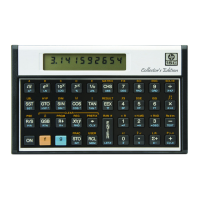116 Section 10: The Index Register and Loop Control
I and e
For the purpose of loop control, the integer portion (the counter value) of
the stored control number can be up to five digits long (nnnnn.xxxyy).
The counter value (nnnnn) is zero if not specified otherwise.
xxx, in the decimal portion of the control number, must be specified as a
three-digit number. (For example, “5” must be “005”.) xxx is zero if not
specified otherwise. Whenever I or e
is encountered, nnnnn is
compared internally to xxx, which represents the end level for
incrementing or decrementing.
yy must be specified as a two-digit number. yy cannot be zero, so if left
(or specified) as 00, the value for yy defaults to 1. The value nnnnn is
altered by the amount of yy each time the loop runs through I or
e. Both yy and xxx are reference values, which do not change with
loop execution.
Indirect Display Control
While you can use the Index register to format the display manually (that
is, from the keyboard), this function is most commonly used in
programming. This capability is especially valuable for the f function,
for which accuracy can be stipulated by specifying the number of digits to
be displayed (as described in Section 14).
There are, as usual, certain display limitations to keep in mind. Recall that
any display format function merely alters the number of decimal places
to which the display is rounded. In its memory, the calculator always
retains a number in scientific notation as a 10-digit mantissa with a two-
digit exponent.
The integer portion of the number in the Index register specifies the
number of decimal places to which the display is rounded. A number less
than zero defaults to zero (zero decimal places displayed in • format),
while a number greater than 9 defaults to 9 (9 decimal places displayed
in •).
*
*
Note that in i and ^ format modes, the maximum display is a seven-digit
mantissa with a two-digit exponent. However, a format number greater than six (and
less than or equal to nine) will alter the decimal place at which rounding occurs. (Refer
to pages 58–59.)

